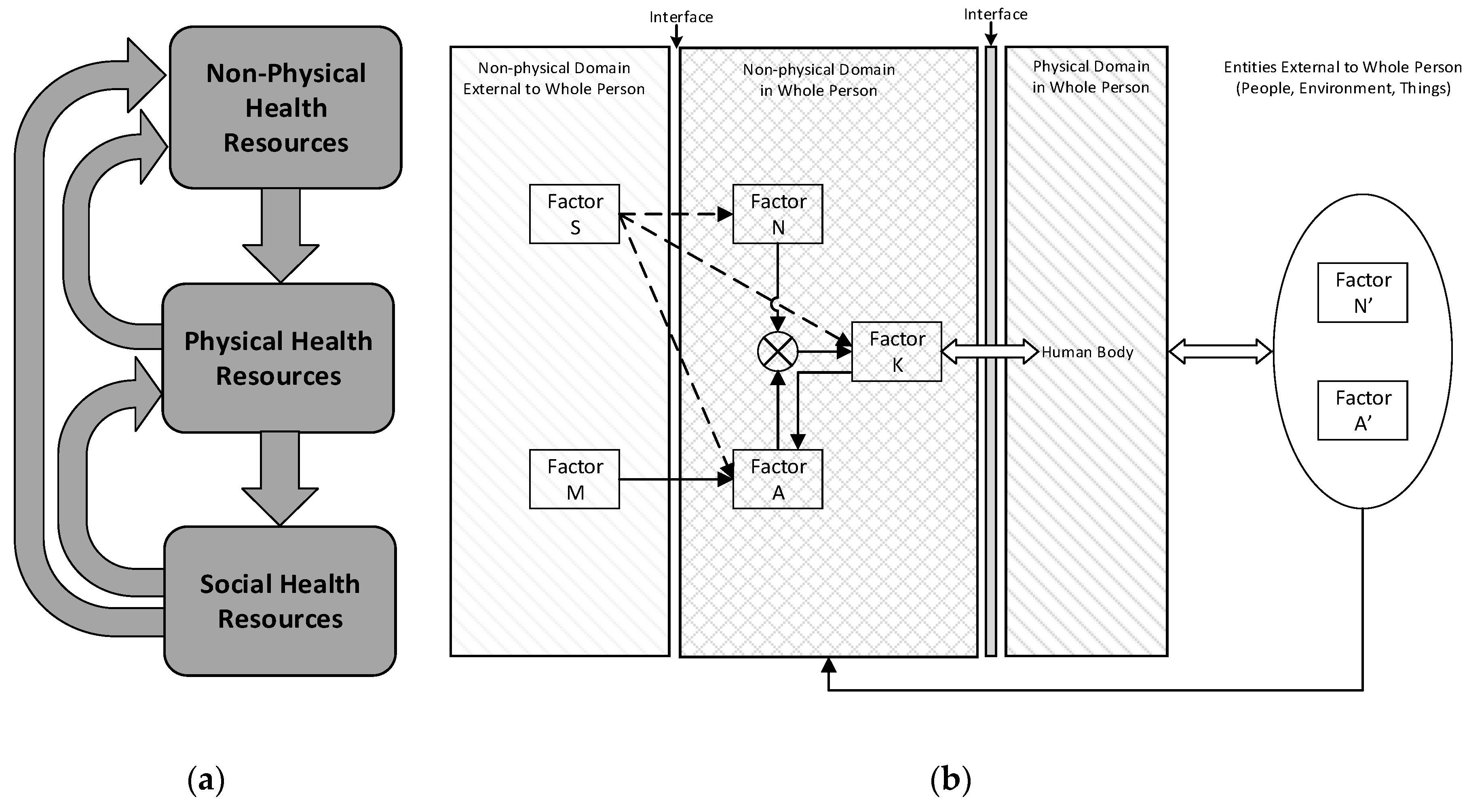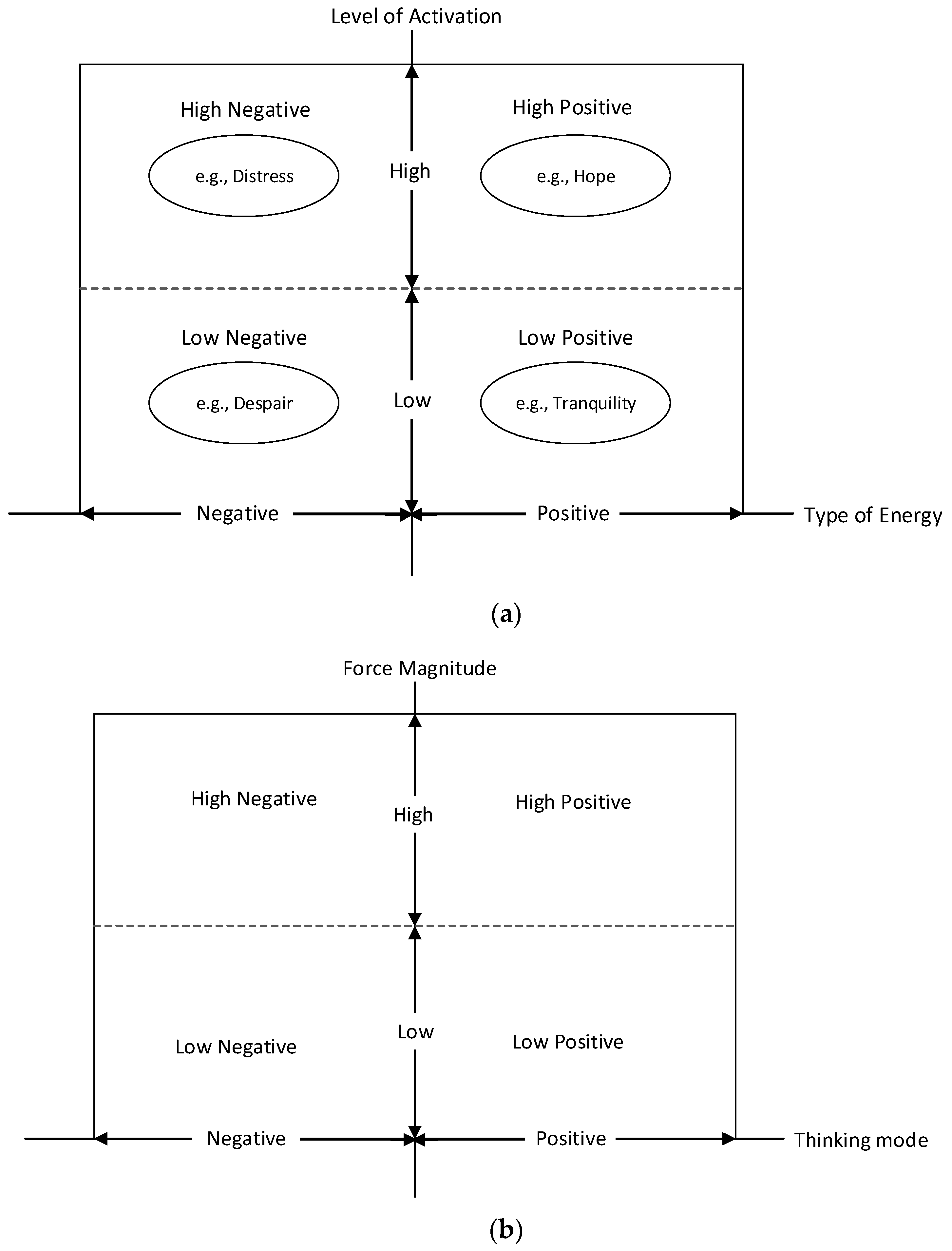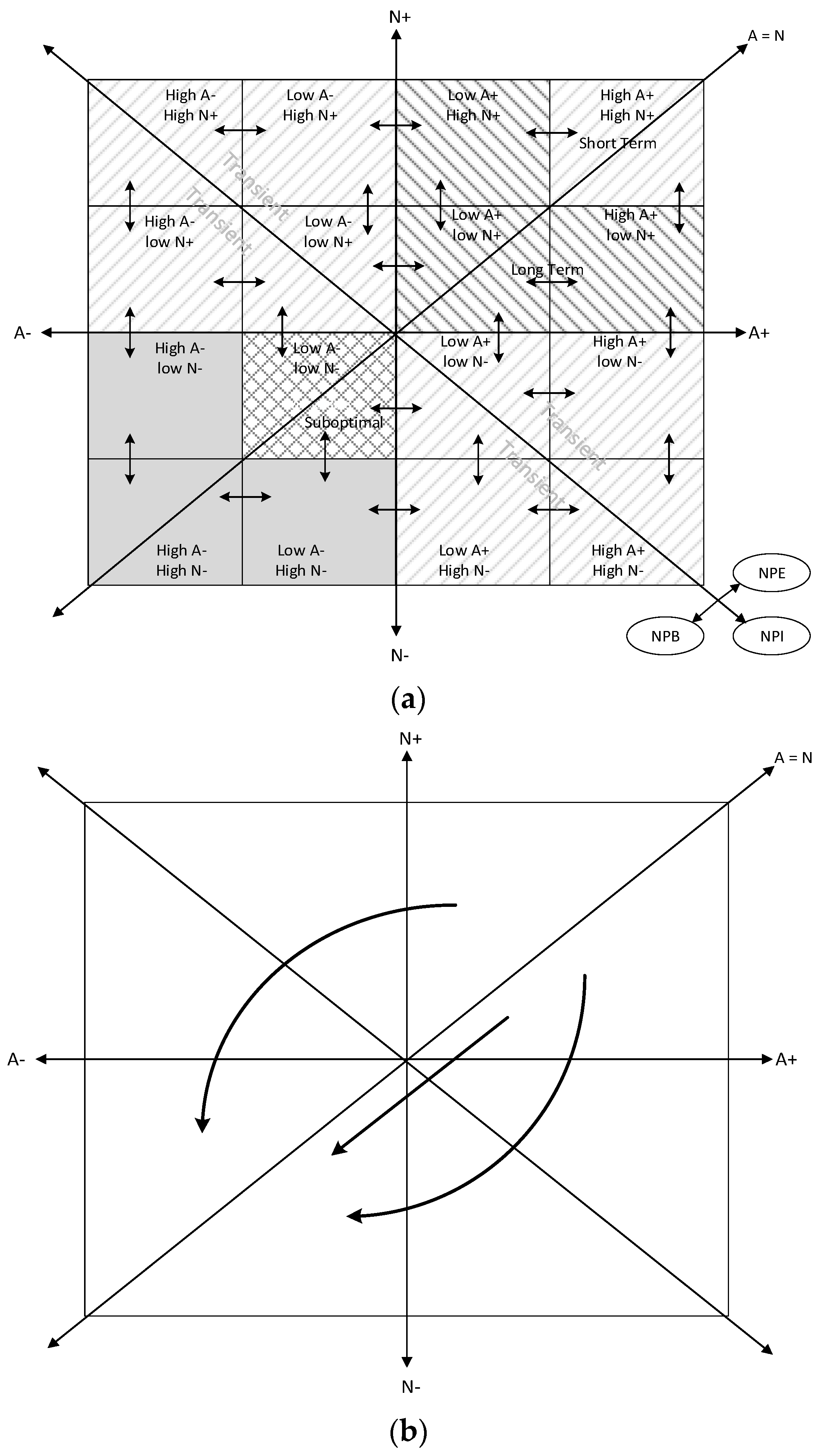A System-of-Systems Framework for Improved Human, Ecologic and Economic Well-Being
Abstract
:1. Introduction
1.1. Overview of Prior Models
1.2. Study Goal
2. Person-Focused Architecture
2.1. Background
2.2. Model Description
- (a)
- Factor A is a rational component that is powered by the voice of reason and logic. It is modeled as a bipolar force (i.e., cognitive force), assuming that the power of logic and reason is modeled as a positive phenomenon and the power of illogic and unreason is regarded as a negative phenomenon.
- (b)
- Factor N is the source of energy for the person, but with limited logic and reason capabilities (i.e., impulsive energy). This source of energy can be positive (i.e., enhancing the person’s capability) or negative (i.e., diminishing the person’s capability).
- (c)
- Factors A and N are in constant interaction with the resultant value providing an input to factor K.
- (d)
- Factor K is the recipient and integrator of information from the internal milieu via factors A and N as well as factors S and M (see below). Structurally, it combines attributes of factors A and N for post-processing purposes. In addition, Factor K has extra sensory capabilities connecting it with the external environment for receipt of information input via two mechanisms: (1) directly via the channels of communication of the body (e.g., visual, auditory); and (2) indirectly by other means unknown to us. Information from the external environment is passed via factor K without any further processing to factor A for storage in its internal memory. This information is also temporarily stored in the memory of factor K for later usage in a decision making process in a given situation. Collectively, factor K renders the final decision on the basis of information from the internal and external milieus for action item orders to the outer layer. After it is made, information on the final decision is passed to factor A where it is stored in the long-term memory, residing as part of its cumulative experience amassed over the course of diverse situations and scenarios. (A note of clarification is warranted on the unknown route of information input to factor K. This mechanism can be activated for example in extreme circumstances such as emergency situations or near death experiences).
- (e)
- Factor M is a positive phenomenon and provides consultative reason and logic to factor A via a one-to-one relationship. This unipolar positive phenomenon also has direct input to factor K, particularly at times when the internal milieu is in a great state of turbulence.
- (f)
- Factor S is a negative complex phenomenon and interacts with factors N, A and K via a one-to-many relationship. Its goal is to augment the power of unreason and to diminish the power of reason via continuous monitoring of the inner layer in the PFA.
2.3. Supporting Evidence for Model Components
2.4. Analytic Perspective of Component Interactions
3. Model Applications
3.1. Nonphysical Syndrome
3.2. Broadened Minds
- “Doing Good” signifies the necessity of satisfying the needs and wants of all stakeholders without exception. As one can imagine, this axiom carries a long-term time span into it (as opposed to short fixes). It is not designed to be a disruptive action. Indeed, the action plan will consist of an inventory of solutions designed to incrementally and steadily improve system performance for all stakeholders at the same time. “Doing Good” enriches the SEE stakeholders by exploiting all potential positive energy and attributes of the system in a way that activates the “Non-physical Enhancers” for all social agents.
- “Not Doing Bad” is the other side of the coin of “Doing Good”, with the intent of preventing and filtering out bad and wicked actions from finding entry to the SEE system. It stipulates the criticality of avoiding conflicts and incompatibility among the SEE constituents. This component of the axiom is achieved via the control and minimization of the “Non-Physical Blockers” for all social agents representing the SEE system.
- Either “Doing Good” or “Not Doing Bad” is a necessary condition but neither is individually sufficient on its own to induce the outcome of “Good Business”. Both components are necessary and sufficient to produce the steady and incremental outcomes of “Good Business”. This is essential both to activate and promote the system’s adaptive properties and to deactivate and dampen the system’s maladaptive properties.
4. Discussion and Concluding Remarks
Acknowledgments
Author Contributions
Conflicts of Interest
Abbreviations
| Acronyms | |
| ENM | Engineered nanomaterials |
| MAS | Maladaptive syndrome |
| MMP | Multimorbid patient |
| NPB | Nonphysical blocker |
| NPE | Nonphysical enhancer |
| NPI | Nonphysical indifferent (an intermediary of NPB and NPE) |
| NPS | Nonphysical syndrome |
| PFA | Person focused architecture |
| SEE | society, environment, economy |
| Major Factors | |
| A | Rational, reasonable and logical factor |
| N | Energy producing factor |
| K | Decision making factor, based upon input from all other factors |
| M | Positive influencing factor (Compare with factor S) |
| S | Negatively influencing factor (Compare with factor M) |
References
- Fiksel, T.; Graedel, A.D.; Hecht, D.; Rejeski, D.; Sayer, G.S.; Senge, P.M.; Swackhamer, D.L.; Theis, L.T. EPA at 40: Bringing Environmental Protection into the 21st Century. Environ. Sci. Technol. 2009, 43, 8716–8720. [Google Scholar] [CrossRef] [PubMed]
- Williams, P.R.D.; Dotson, G.S.; Maier, A. Cumulative Risk Assessment (CRA): Transforming the Way We Assess Health Risks. Environ. Sci. Technol. 2012, 46, 10868–10874. [Google Scholar] [CrossRef] [PubMed]
- Depledge, M.H.; Stone, R.J.; Bird, W.J. Can Natural and Virtual Environments Be Used to Promote Improved Human Health and Wellbeing? Environ. Sci. Technol. 2011, 45, 4660–4665. [Google Scholar] [CrossRef] [PubMed]
- Simon, H.A. A Behavioral Model of Rational Choice. Q. J. Econ. 1995, 69, 99–118. [Google Scholar] [CrossRef]
- Simon, H.A. Rational Choice and the Structure of the Environment. Psychol. Rev. 1956, 63, 129–138. [Google Scholar] [CrossRef] [PubMed]
- Simon, H.A. Motivational and Emotional Controls of Cognition. Psychol. Rev. 1967, 74, 29–39. [Google Scholar] [CrossRef] [PubMed]
- Barabasi, A.L. The Origin of Bursts and Heavy Tails in Human Dynamics. Nature 2005, 435, 207–211. [Google Scholar] [CrossRef] [PubMed]
- Karwowski, W. A Review of Human Factors Challenges of Complex Adaptive Systems Discovering and Understanding Chaos in Human Performance. Hum. Factors 2012, 54, 983–995. [Google Scholar] [CrossRef] [PubMed]
- Pentland, A.; Liu, A. Modeling and Prediction of Human Behavior. Neural Comput. 1999, 11, 229–242. [Google Scholar] [CrossRef] [PubMed]
- Bonabeau, E. Agent-Based Modeling: Methods and Techniques for Simulating Human Systems. Proc. Natl. Acad. Sci. USA 2002, 99, 7280–7287. [Google Scholar] [CrossRef] [PubMed]
- Homer, J.B.; Hirsch, G.B. System Dynamics Modeling for Public Health: Background and Opportunities. Am. J. Public Health 2006, 96, 452–458. [Google Scholar] [CrossRef] [PubMed]
- Janssen, M.A.; Walker, B.H.; Langridge, J.; Abel, N. An Adaptive Agent Model for Analyzing Co-evolution of Management and Policies in a Complex Rangeland System. Ecol. Model. 2000, 131, 249–268. [Google Scholar] [CrossRef]
- Jager, W.; Janssen, M.A.; de Vries, H.J.M.; de Greef, J.; Vlek, C.A.J. Behavior in Commons Dilemmas: Homo Economicus and Homo Psychologicus in an Ecological-Economic Model. Ecol. Econ. 2000, 35, 357–379. [Google Scholar] [CrossRef]
- Bagozzi, R.P. Alternative Perspectives in Philosophy of Mind and Their Relationship to Structural Equation Models in Psychology. Psychol. Inq. 2011, 22, 88–99. [Google Scholar] [CrossRef]
- Kusmartsev, F.V.; Kurten, K.E. Physics of the Mind: Opinion Dynamics and Decision Making Processes Based on a Binary Network Model. Int. J. Mod. Phys. B 2008, 22, 4482–4494. [Google Scholar] [CrossRef]
- Pojola, C.; Stanculete, M.F. Biopsychosocial approach of gastrointestinal disorders. Clujul Med. 2014, 87, 95–97. [Google Scholar]
- Kerr, C. Translating “Mind-In-Body”: Two Models of Patient Experience Underlying a Randomized Controlled Trial of Qigong. Cult. Med. Psychiatry 2002, 26, 419–447. [Google Scholar] [CrossRef] [PubMed]
- Iyer, I.; Albert, P.B.; Devi, S.M.A.; Devi, S.M.A.; Rakkiappan, C.N.; Mohanan, M.; Maharaj, D.O. The Science of Manifestations by God and Divinity leading to Inspiration and Persistence as Holy Books or Holy Sites or Evolved/Systematic Holy Ways of Life—A consequence of the Evolution of the Mind and the Heart inspired by Consciousness fields as explained in the New Consciousness model which scientifically converges Science and Spirituality with converged scientific and spiritual insights into the aspects of God, Soul, Karma, Birth and Re-birth, Machine Consciousness and Awareness, Plants, Animals, All Life, Natural and non-Natural forms and Convergence of Religious Teachings. Int. J. BioSci. Technol. 2013, 6, 37–73. [Google Scholar]
- Tolaymat, T.; El Badawy, A.; Sequeira, R.; Genaidy, A. A System-of-Systems Approach as a Broad and Integrated Paradigm for Sustainable Engineered Nanomaterials. Sci. Total Environ. 2015, 511, 595–607. [Google Scholar] [CrossRef] [PubMed]
- Shilling, C.; Mellor, P.A. Embodiment, Structuration Theory and Modernity: Mind/Body Dualism and the Repression of Sensuality. Body Soc. 1996, 2, 1–15. [Google Scholar] [CrossRef]
- Sperry, R.W. Mind-Brain Interaction: Mentalism, Yes; Dualism, No. Neuroscience 1980, 5, 195–206. [Google Scholar] [CrossRef]
- Borrell-Carrio, F.; Suchman, A.L.; Epstein, R.M. The Biopsychosocial Model 25 Years Later: Principles, Practice and Scientific Enquiry. Ann. Fam. Med. 2004, 2, 576–582. [Google Scholar] [CrossRef] [PubMed]
- Alonso, Y. The Biopsychosocial Model in Medical Research: The Evolution of the Health Concept over the Last Two Decades. Patient Educ. Couns. 2004, 53, 239–244. [Google Scholar] [CrossRef]
- Engel, G.L. The Need for a New Medical Model: A Challenge for Biomedicine. Science 1977, 196, 129–136. [Google Scholar] [CrossRef] [PubMed]
- Brown, T.M. Cartesian Dualism and Psychosomatics. Psychosomatics 1989, 30, 322–331. [Google Scholar] [CrossRef]
- Engel, G.L. How Much Longer Must Medicine’s Science Be Bound by a Seventeenth Century World View? Psychother. Psychosom. 1992, 57, 3–16. [Google Scholar] [CrossRef] [PubMed]
- Wade, D.T.; Halligan, P.W. Do Biomedical Models of Illness Make for Good Healthcare Systems? Br. Med. J. 2004, 329, 1398–1401. [Google Scholar] [CrossRef] [PubMed]
- Wade, D. Complexity, Case-Mix and Rehabilitation: The Importance of a Holistic Model of Illness. Clin. Rehabil. 2011, 25, 387–395. [Google Scholar] [CrossRef] [PubMed]
- Greene, R.A.; Dasso, E.; Ho, S.; Frank, J.; Scandrett, G.; Genaidy, A.M. Patterns and Expenditures of Multi-morbidity in an Insured Working Population in the United States: Insights for a Sustainable Health Care System and Building Healthier Lives. Popul. Health Manag. 2013, 16, 381–389. [Google Scholar] [CrossRef] [PubMed]
- Greene, R.A.; Dasso, E.; Ho, S.; Genaidy, A.M. A Person-Focused Model of Care for the Twenty-First Century: A System-of-Systems Perspective. Popul. Health Manag. 2014, 17, 166–671. [Google Scholar] [CrossRef] [PubMed]
- Genaidy, A.; Karwowski, W.; Shoaf, C. The Fundamentals of Work System Compatibility Theory: An Integrated Approach to Optimize Human Performance at Work. Theor. Issues Ergon. Sci. 2002, 3, 346–368. [Google Scholar] [CrossRef]
- Genaidy, A.; Salem, O.; Karwowski, W.; Paez, O.; Tuncel, S. The Work Compatibility Improvement Framework: An Integrated Perspective of the Human-At-Work System. Ergonomics 2007, 50, 3–25. [Google Scholar] [CrossRef] [PubMed]
- Boardman, J.; Sauser, B. System of Systems—The meaning of of. In Proceedings of the IEEE International Conference on System of Systems Engineering, Los Angeles, CA, USA, 24–26 April 2006; pp. 118–123. [Google Scholar]
- Gorod, A.; Sauser, B.; Boardman, J. System-of-Systems Engineering Management: A Review of Modern History and a Path Forward. IEEE Syst. J. 2008, 2, 484–499. [Google Scholar] [CrossRef]
- DiMario, M.J.; Boardman, J.T.; Sauser, B.J. System of Systems Collaborative Formation. IEEE Syst. J. 2009, 3, 360–368. [Google Scholar] [CrossRef]
- Dember, W.N.; Jenkins, J.J.; Teyler, T.J. The Group: Social Roles and Social Impact. In General Psychology, 2nd ed.; Wm. C. Brown: Dubuque, IA, USA, 1984; Chapter 18; pp. 731–739. [Google Scholar]
- Dember, W.N.; Jenkins, J.J.; Teyler, T.J. The Group: Social Interaction. In General Psychology, 2nd ed.; Wm. C. Brown: Dubuque, IA, USA, 1984; Chapter 19; pp. 761–797. [Google Scholar]
- Cohen, A. Heat, Stress, and Workload in an Era of Workplace Change, Ergonomics and Human Factors; Mark, L.S., Warm, J.S., Huston, R.L., Eds.; Springer: New York, NY, USA, 1987; pp. 155–169. [Google Scholar]
- Hancock, P.A. Arousal theory, stress and performance: Problems of incorporating energetic aspects of behavior into human-machine systems function. In Ergonomics and Human Factors; Mark, L.S., Warm, J.S., Huston, R.L., Eds.; Springer: New York, NY, USA, 1987; pp. 170–179. [Google Scholar]
- Seery, M.D. The Biopsychosocial Model of Challenge and Threat: Using the Heart to Measure the Mind. Soc. Personal. Psychol. Compass 2013, 7, 637–653. [Google Scholar] [CrossRef]
- Starfield, B. Is patient care the same as person-focused care? Perm. J. 2011, 15, 63–69. [Google Scholar] [CrossRef] [PubMed]
- Jakovljevic, M.; Ostojic, L. Comorbidity and Multimorbidity in Medicine Today: Challenges and Opportunities for Bringing Separated Branches of Medicine Closer to Each Other. Psychiatra Danub. 2013, 25, 18–28. [Google Scholar]
- Burton, C. (Ed.) ABC of Medically Unexplained Symptoms; Wiley-Blackwell: Oxford, UK, 2013. [Google Scholar]
- Organization for Economic Co-operation and Development (OECD). Important Issues on Risk Assessment of Manufactured Nanomaterials; OECD: Paris, France, 2012. [Google Scholar]
- Fredrickson, B.L. The role of positive emotions in positive psychology: The broaden-and-build theory of positive emotions. Am. Psychol. 2001, 56, 218. [Google Scholar] [CrossRef] [PubMed]




© 2017 by the authors. Licensee MDPI, Basel, Switzerland. This article is an open access article distributed under the terms and conditions of the Creative Commons Attribution (CC BY) license (http://creativecommons.org/licenses/by/4.0/).
Share and Cite
Genaidy, A.M.; Huston, R.L.; Dionysiou, D.D.; Karwowski, W. A System-of-Systems Framework for Improved Human, Ecologic and Economic Well-Being. Sustainability 2017, 9, 616. https://doi.org/10.3390/su9040616
Genaidy AM, Huston RL, Dionysiou DD, Karwowski W. A System-of-Systems Framework for Improved Human, Ecologic and Economic Well-Being. Sustainability. 2017; 9(4):616. https://doi.org/10.3390/su9040616
Chicago/Turabian StyleGenaidy, Ash M., Ronald L. Huston, Dionysios D. Dionysiou, and Waldemar Karwowski. 2017. "A System-of-Systems Framework for Improved Human, Ecologic and Economic Well-Being" Sustainability 9, no. 4: 616. https://doi.org/10.3390/su9040616




_Dionysiou.jpg)
